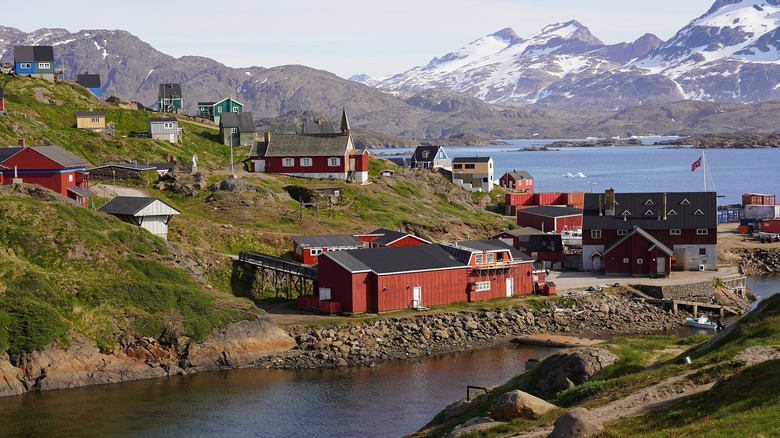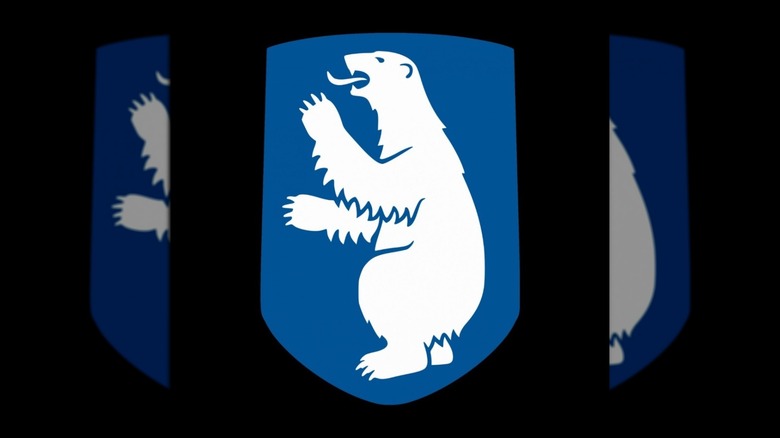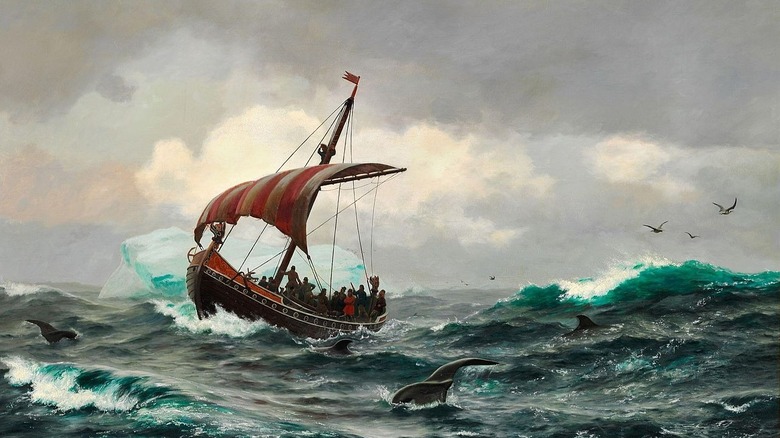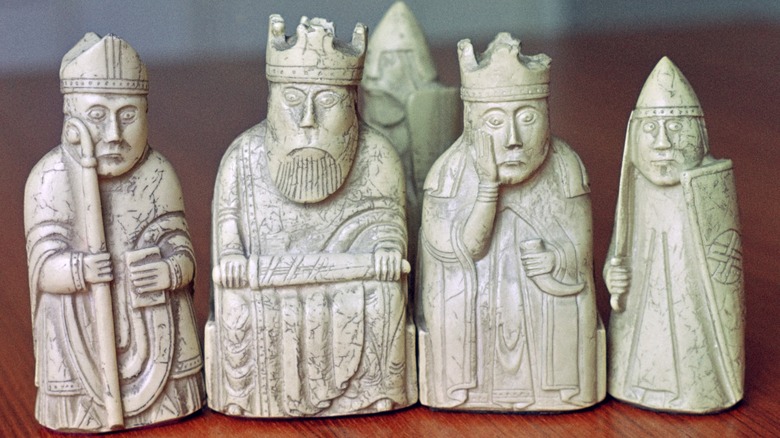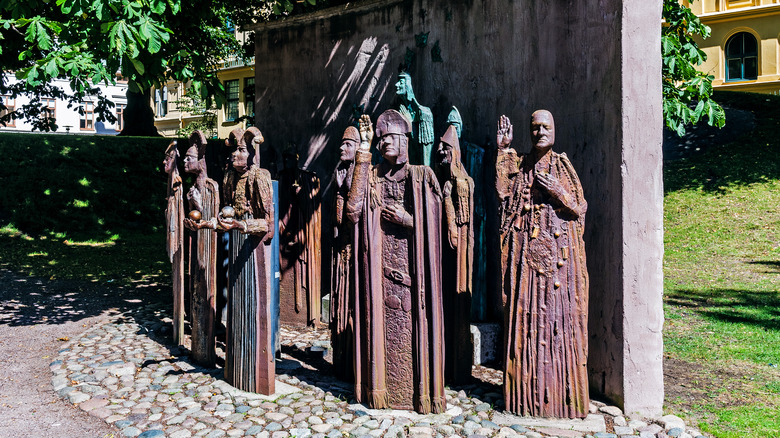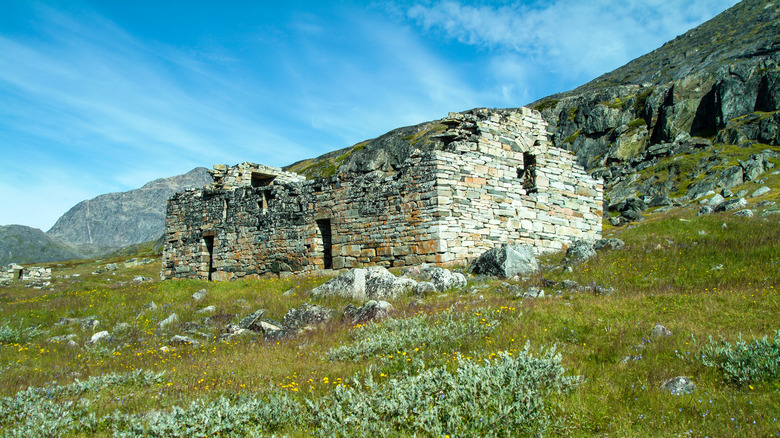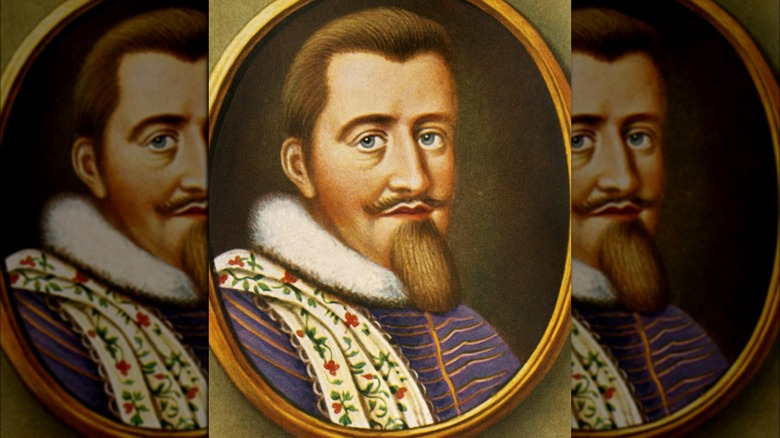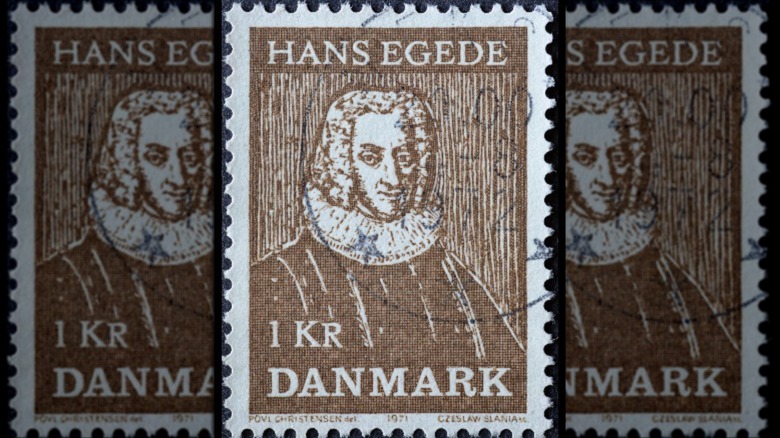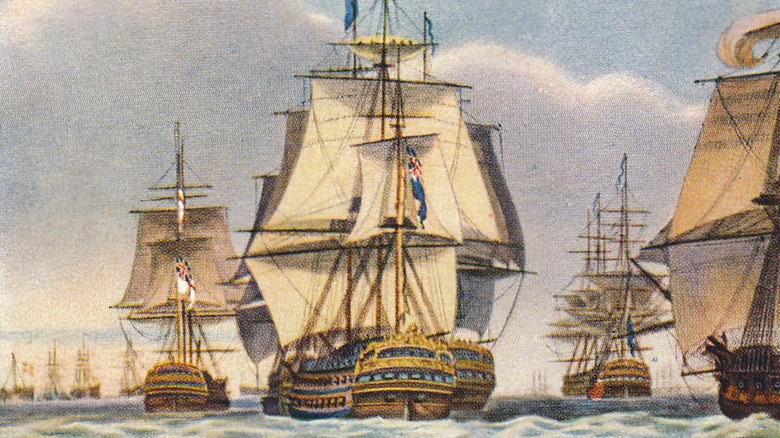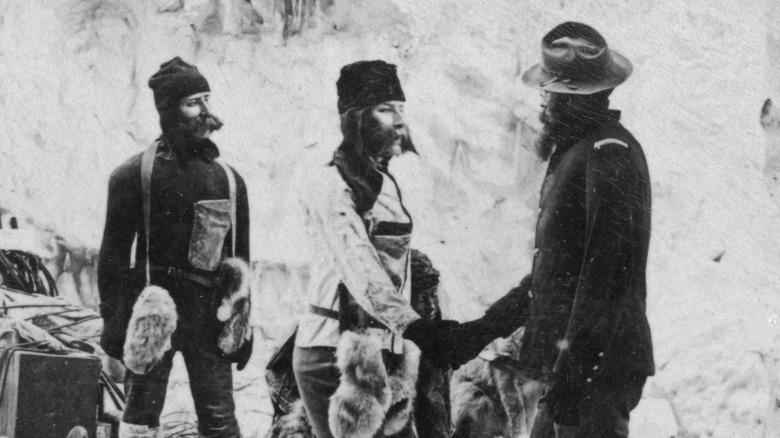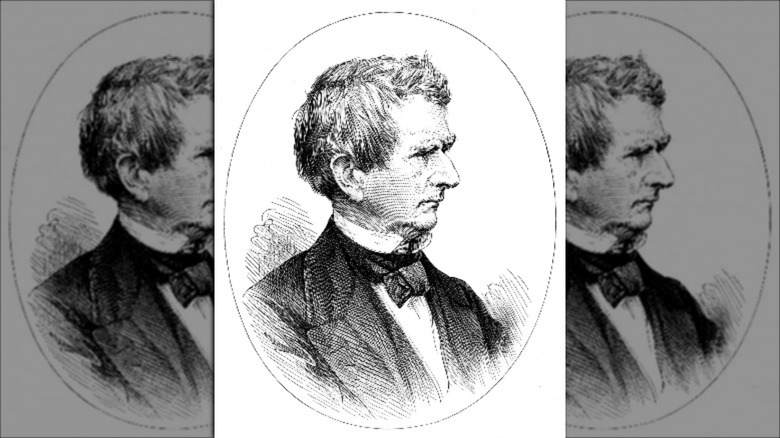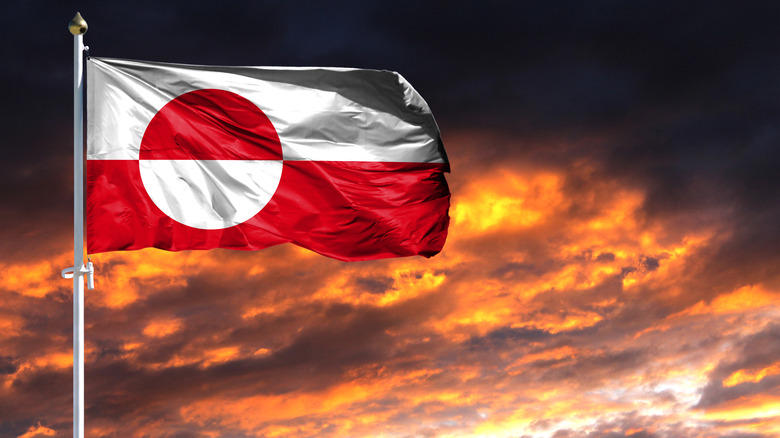The Real Reason Denmark Owns Greenland
Greenland — the ultimate misnomer. Not very green and covered in ice, this harsh land, located in the very far north of the globe, was the Hyperborea of the Renaissance, an unknown, unforgiving place of lost Vikings, ice, and polar bears. Today, Greenland rarely crosses the American mind, aside from when U.S. president Donald Trump expressed interest in buying it from the Danish crown. This begs the question: How did a territory so close to North America, whose people speak a language related to the Inuit of Canada and Alaska, end up under Danish rule?
Despite Greenland's inhospitable climate, the island has a rich history as the first point of transatlantic contact between the Old and New Worlds that has brought together Inuit and Scandinavian influences since Viking times. It is a history that continues to be written today as the island marches towards nationhood and independence as it attempts to negotiate its identity and role in an increasingly globalized world.
Semantics: Denmark does not 'own' Greenland
Before jumping into the history of Greenland's ownership, it is important to clear up misconceptions about its status. Greenland is a self-governing territory, not a colony of Denmark, and according to NPR, Denmark does not own it. It has its own prime minister, parliament, and governing institutions. However, it frequently appears on maps as "part" of Denmark.
This confusion arises from two different entities that exist simultaneously. Denmark is a country in the same sense that England is a country. Together with the Faroe Islands and Greenland, it forms the Kingdom of Denmark, a separate entity, whose sovereign is Queen Margarethe II. This gives Greenland a similar status to the Channel Islands or the Isle of Man, which are both constituents of the United Kingdom of Great Britain and Ireland.
As a result of this arrangement, Greenland functions in many ways as an independent state. The Inuit language Kalaallisut is the territory's sole official language (Danish is used, too), and it preserves a distinct culture from that of its Danish sovereign. However, Greenland has only officially been Danish since 1814, and since then, Denmark has jealously guarded its possession of the island.
From humble Viking beginnings...
The story of sovereignty in Greenland revolves around Danish, Norwegian, and Inuit claims. Although the Inuit are considered Greenland's indigenous inhabitants, they're relatively recent arrivals that displaced the Dorset from the extreme northwest of the island around A.D. 1200, giving the Scandinavian countries a historical claim dating back to the Viking Age.
The Nordic claim rests upon Greenland's 10th-century Norse colonies. The famous Viking chieftain and explorer Erik the Red, according to his Saga, was convicted of murder in Iceland and sailed west in exile, reaching Greenland. Over time, Norse settlers built three main settlements in Greenland, where, according to Smithsonian Magazine, they subsisted on animal husbandry and seal and walrus hunting. Norse hunters did not restrict themselves to the extreme south, instead venturing as far north as Disko Bay to search for ivory.
Greenland became a launching pad for the Norse exploration of the Americas. Beginning with Leif Erikson, Norse expeditions explored Newfoundland and built a short-lived settlement at L'Anse aux Meadows. Despite the harsh weather, the Norse settlements of Southern Greenland had no competition. Canada's Dorset had only reached Greenland's remote Northwest, while the Inuit had not yet made an appearance. Between the 10th and 15th centuries, the settlements thrived under Norwegian rule, which opened Europe up to the Greenlandic ivory trade.
Greenland prospers under Norway
The Greenland colonies were administered from Iceland for the first three centuries of their existence. As they became more prosperous, they caught the attention of the Kingdom of Norway, which sought to bring the Greenlandic Norse under its rule. Haakon IV successfully negotiated a deal that brought Greenland into the Norwegian Kingdom in 1261.
According to the Saga of Haakon IV, the original Greenland Norse had fled Norway to escape the harsh rule of Harald the Fair-hair, Norway's first king. Since the Greenlanders, along with their Icelandic cousins, had no overlord, Haakon offered to bring them under his protection as Norwegian subjects, dispatching clergymen to negotiate oaths of loyalty from the two islands. Four years later, they returned, having secured a tribute called the skatt and control over Greenland's legal institutions, which effectively forfeited the island's independence.
Norwegian rule opened Greenland up to the rest of Europe, and the settlements reached their zenith. According to Smithsonian Magazine, the colonies supplied Europe with highly desired walrus ivory, imported via Norway's coastal cities and the British Isles. Among the most beautiful pieces is the magnificent Lewis Chess Set, crafted from Greenlandic ivory by Norwegian craftsmen in Trondheim. With this lucrative income, the Greenland Norse built churches, convents, and even the St. Nicholas Cathedral, which holds the distinction as the oldest building of its type in the New World.
Denmark enters the scene
Greenland's history had been intimately connected with Norway and Iceland since the days of Erik the Red. Denmark and Sweden had focused on expansion in the Baltic and Eastern Europe, so neither state ever made any claims on Greenland until the Late Middle Ages.
In 1397, Greenland entered the world of pan-Scandinavian politics as the Danish crown laid the foundation for its later claims on the territory. Political maneuvering and the complexities of medieval dynastic succession allowed Queen Margarethe I of Denmark to unite the three Scandinavian kingdoms — Denmark, Norway, and Sweden — under one ruler, her grand-nephew Erik of Pomerania (via Britannica).
The Union of Kalmar, as it was called, included the three major kingdoms in addition to Finland (part of Sweden), Iceland, Greenland, and the Shetland and Faroe Islands (Norway). But this union did not create a politically united Scandinavia. Instead, the three kingdoms all came to share a single monarch, Erik, while remaining independent states that preserved their nobilities and governing institutions. Although Denmark led the union, it could be broken upon the death of a king if the nobles willed it.
Under the Union of Kalmar, the kingdoms' boundaries remained intact, so Greenland continued under Norwegian rule. If Denmark and Norway were to separate, then these lands should have passed to a new Norwegian king. Two events between the 16th and 19th centuries, however, left Greenland in Denmark's possession and were not fully resolved until the 20th century.
The disappearance of the Greenland Norse
By the 16th century, the question of authority over Greenland was a moot point because there were no longer any Norse living there. Beginning in the 14th century, the once-thriving Greenland Norse settlements shrank and were abandoned over the next two centuries.
The decline of the settlements is debated, but it is likely that the Black Death, which, according to National Geographic, killed over a third of Europe's population, played some role. During the centuries following the Plague, a phenomenon called the Little Ice Age struck Europe, resulting in harsh winters that made survival in the already harsh Arctic more difficult. According to NASA, the cooling and increase in glacier ice isolated Greenland and Iceland from Europe.
To the northwest, the Norse colonies faced a new opponent: the recently arrived Inuit. These newcomers had displaced the Dorset from Canada and Northwestern Greenland and had pushed all the way into the south of the island, where the Norse colonies were located. Inuit legends preserve the memory of open conflict with the Norse, whom the Inuit called Kavdlunait. The "Tale of Ungortok" describes the Inuit destruction of one of the settlements. However, there is not archaeological evidence for violent destruction, and scholarly consensus, according to Smithsonian Magazine, is that the Norse Greenlanders simply left for Iceland as the market for walrus ivory declined, making the colonies economically unviable.
The expeditions of King Christian IV
Between the abandonment of the Greenland settlements and the Danish colonization of 1721, Greenland continued to be legally part of Norway even though its king wielded no authority there. The Inuit were the island's de facto rulers, and there was no more interest in Greenland until the Age of Discovery. The Iberian expeditions to America and Asia set off a firestorm of exploration as European nations competed to establish colonies in the New World and find the fabled Northwest Passage. Scandinavia and Greenland were caught in the rush.
Under the 1494 Treaty of Tordesillas, the papacy made Greenland the sole domain of Portugal and barred other Catholic nations from colonizing the island. According to author William Mills, Portuguese explorers tried to reach Greenland but were repeatedly thwarted by thick ice and the harsh, unforgiving cold. As the Protestant Reformation spread, England ignored papal edicts and took an interest in the polar regions as a stepping-stone to North America.
In the early 1600s, King Christian IV of Denmark-Norway attempted to reassert Scandinavian sovereignty over Greenland before England, or some other European power, claimed it first. According to the Dictionary of Canadian Biography, Christian sent three expeditions under English captain James Hall in the hope of finding Greenlandic Norse survivors to establish Danish rule there. The search for the Eastern Settlement, the largest of the three, failed, but the sailors' accounts provided valuable cartographic information about Greenland that would permit Danish colonization in the 18th century.
Hans Egede's mission
Unfamiliarity with the icy waters of the North Atlantic and the location of the Eastern Settlement doomed Danish efforts until 1721. As the Little Ice Age abated, Norwegian Lutheran missionary Hans Egede renewed the crown's mission to find the lost Norse.
Per the Gospel Fellowship Association, Egede believed that some Norse must have survived on Greenland as Catholics (despite the Reformation) or had abjured Christianity altogether. Despite months of searching, Egede found no trace of any survivors, just Inuit, so he decided to learn the local dialect and convert the Inuit to Christianity, preparing Greenland for Danish colonization. The colony received new life when a shipment of Moravian missionaries established Godt-Haab (today the capital Nuuk) on Greenland's western coast. Dutch whalers, Danish-Norwegian hunters, and converted Inuit followed, and the Danish settlements in Greenland began to grow, despite a smallpox outbreak that killed Egede's wife Gertrude.
According to Visit Greenland, Egede's legacy is split. Although he led the Danish colonization, his efforts and faith gave the world the Gospels in Inuit, a difficult task due to Inuit's limited vocabulary (e.g. Egede replaced the word "bread" with "seal"). His tireless care for all sick, Dane or Inuit, made him Greenland's unofficial patron saint, and he is revered to this day for his compassion and tenacity despite the negative consequences of the Danish colonization. If Denmark owes any one person its possession of Greenland, it is Hans Egede.
Greenland becomes officially Danish
Egede's efforts handed Denmark de facto possession of Greenland, but it did not become de jure until 1814. Ironically, the change in Greenland's status resulted from a Danish defeat to Sweden during the Napoleonic Wars. Napoleon's drive through Europe forced many smaller states to pick sides in the numerous wars between the French emperor and the coalitions arrayed against him. Denmark, however, chose to remain neutral until a violent British attempt to pre-empt a French capture of Denmark's merchant fleet drove the Danes into Napoleon's camp.
In a parallel development, Napoleon's general Jean-Baptiste Bernadotte became crown prince of Sweden through marriage in 1810 (and would later be king). According to the Norwegian Royal House, Sweden had lost Finland to Russia in 1809, so Marshal Bernadotte, aka Karl XIV Johan of Sweden, wanted to make up for it. The new Swedish prince sided against his former emperor to pry Norway from its 400-year-old union with Denmark.
Napoleon's 1813 defeat at Leipzig allowed Sweden to realize its expansionist ambitions. Swedish troops occupied Danish territory with British blessing, and Fredrik VI of Denmark quickly capitulated to their demands. In the 1814 Treaty of Kiel, Denmark renounced all claims to the Kingdom of Norway, which, in theory, should have transferred Norway's overseas possessions to Sweden, too. However, the treaty only enumerated Norway proper. Article IV crucially exempted Greenland, Iceland, and the Faroe Islands, from Norwegian sovereignty. These historic Norwegian territories were left to Denmark, creating the geopolitical paradigm that exists today.
The five-man occupation
The Treaty of Kiel transferred the settled parts of Greenland to Denmark, but control of the island was still disputed. Denmark had not explored, let alone settled, the whole of Greenland. Much of it was still uninhabited at the turn of the 20th century, giving Denmark's competitors the possibility of claiming land under the terra nullius doctrine, per University of Maine professor Charles Norchi. Norwegian claims in 1931 (Norway regained independence in 1905) created a miniature conflict that was settled at the Hague.
According to political scientist Axel Sorens, five Norwegian trappers "occupied" part of East Greenland called Erik the Red's Land. Although this "occupation" consisted merely of planting the Norwegian flag, Denmark perceived this action as a threat to its position in Greenland, mostly due to the race to gain Arctic territory among the world's powers.
The case went to the Hague, which ruled in Denmark's favor. Norway forfeited all claims to Greenland, setting off nationalistic celebrations in Greenland and the Danish capital Copenhagen. Although the Treaty of Kiel had left Greenland to Denmark without Norwegian input, the judges noted that Norway had issued the so-called Ihlen Declaration in 1919. Norwegian foreign minister Nils Ihlen had explicitly voiced, in writing, full Norwegian support for Denmark's sovereignty over all of Greenland in return for Danish recognition of Norway's ownership of the Svalbard Islands.
Trump's predecessors
Although the Norwegian "occupation" of Greenland seemed insignificant, Denmark's insecurity stemmed from real competition with a much more powerful country, the United States. The rising American power sought to expand into Greenland, either through negotiation or through the annexation of Arctic territories.
According to Foreign Policy Magazine, following the famous Alaska Purchase of 1867, Secretary of State William Seward sought to buy both Iceland and Greenland from Denmark in 1868. Seward was motivated by a U.S. Coast and Geodetic Survey/Department of State report cataloguing the resources and economic potential of both islands, which, at the time, appeared to be virtually naught. Robert Walker, the report's author, faced several problems. Most of Greenland was unexplored, and Seward was already under fire for the Alaska Purchase (derisively known before the Alaska Gold Rush as Seward's Icebox). It ultimately did not matter: Denmark was not interested in selling. This refusal laid American territorial ambitions in the Arctic to rest until the early 20th century.
During the late 19th and early 20th centuries, polar expeditions explored and mapped the Arctic as a prelude to a race for territory in the area. According to historian Halbert Jones, American explorers were among the first to chart Greenland's interior, and some even claimed parts of the island for the United States under the Monroe Doctrine. To mitigate a possible American takeover, Denmark specifically requested American recognition of Danish sovereignty in Greenland as a condition for the purchase of the U.S. Virgin Islands, to which Secretary of State Robert Lansing conceded in 1917.
Greenland's road to independence
The United States offered to buy Greenland again in 1947 for $100 million in gold, per TIME Magazine, but Denmark once again refused. As the Cold War moved into the Arctic, Denmark finalized its rule in Greenland. According to the Naalakkersuisut, Greenland's executive cabinet, the island became a Danish province in 1953, making it an integral part of the Danish national territory. However, per the Danish Museum of America, the German occupation of World War II had forced Greenland to fend for itself during the war, leading to the creation of an autonomist and eventually independence movement.
Greenland ceased to be a Danish province in 1979 after its inhabitants voted for home rule as a self-governing territory, a status it continues to enjoy today. Because of the cultural differences between Greenland and Denmark (over 90% of Greenland's population is Inuit), independentist sentiment runs strong, thwarted only by economic dependence on Denmark.
In 2008, Greenland voted itself greater autonomy from Denmark. Embedded in Chapter 8, Section 21 of the law is the right to national self-determination via referendum. Today, opinions are divided. While most Greenlanders favor theoretical independence from Denmark, Danish newspaper DR reported that 78% of Greenlanders were opposed if it meant a decline in living standards and an end to Danish subsidies. In an interview with High North News, then-Greenlandic PM Kim Kieslen (pictured) spoke of the need to diversify Greenland's economy to prepare the country for independence in the face of American and Chinese moves to augment their influence in the Arctic region.
Going forward
Greenland is still part of the Kingdom of Denmark, but current events and shifting geopolitical circumstances make independence an ever more likely possibility as Greenland exerts greater control over its territory without Danish involvement. The Arctic Institute notes that Greenland has become a theater for the U.S.-China rivalry, as Chinese investment in the island's hydrocarbon and mineral resources has been a source of concern for U.S. officials due to Greenland's proximity to North America.
Due to Greenland's economic value, especially its stores of rare earth minerals, U.S. president Donald Trump expressed interest in buying Greenland, as reported in the Wall Street Journal. Despite the ridicule, it made sense in the framework of containing China and reducing U.S. dependence on Chinese tech components. However, it seems much more likely that rather than becoming part of the United States, Greenland will continue to diversify its economy in cooperation with the U.S., Chinese, Russian, and European governments, as noted by TIME Magazine.
If Greenland successfully manages to attract investment to make the territory more viable economically, an independence referendum may very well be in the cards soon. This is the central reason why Denmark still rules over Greenland: If the Danes provide subsidies, Greenland has no reason to break away. Once the island can unlock the full potential of its natural resources, however, the days of Danish rule could be numbered.
